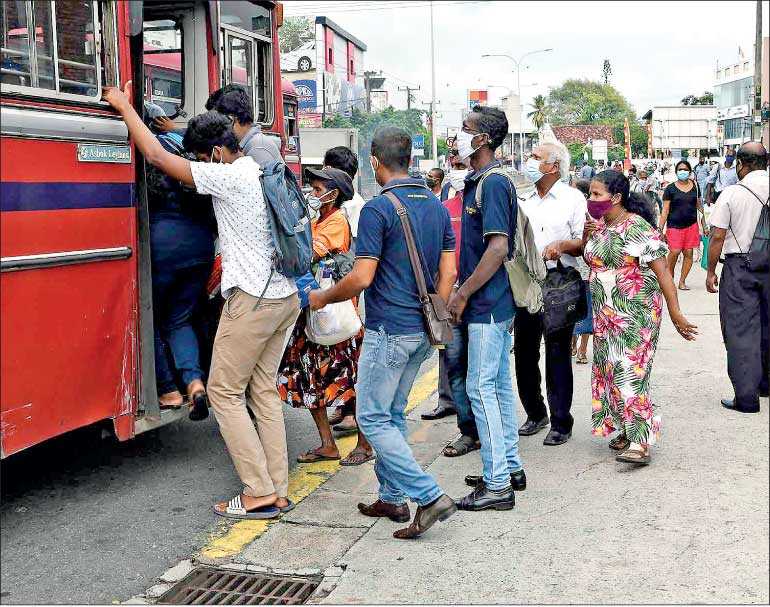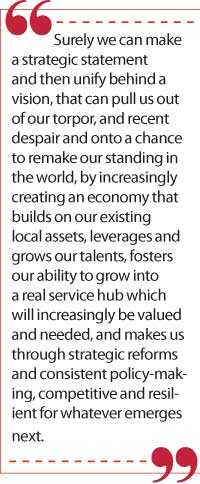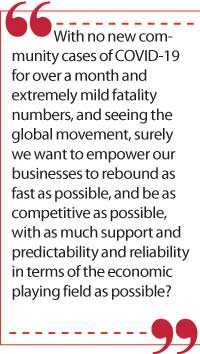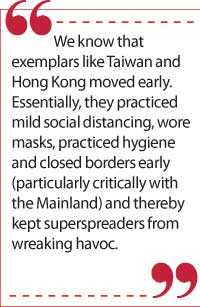Sunday Dec 14, 2025
Sunday Dec 14, 2025
Monday, 8 June 2020 00:10 - - {{hitsCtrl.values.hits}}

“Lockdown” now exists in part as a fiction, except that not everything is still open, and “technically” the guidelines are still in effect in various places. But it is being erratically preached and by and large, not practiced. – Pic by Shehan Gunasekara
The world seems vastly unrecognisable in the space of roughly 10 days.
The UK has been one of the stalwart hold-outs of “lockdown” as country after country in Europe moved to varying degrees of opening, and exemplars like Norway and Denmark said they should have been more like Sweden, and Sweden still doing better than many and certainly not the site of smouldering corpses as the frenzied media Cassandras on the Twitter heath maliciously predicted, suggested they should have taken a few “leaves” from the playbook of their neighbours and been a tad more disciplined (while still staying non-locked down). A “best practice,” non-lockdown playbook was emerging, even echoed by WHO increasingly, and in fact by their head of emergencies Dr. Mike Ryan, for some time.
And then even the lockdown-evading, extra-marital romantic, Neil Ferguson of Imperial College, confessed Sweden had gotten to at least the same positive outcomes hoped for, following their own more iconoclastic route (with far less economic fall-out, as the economy has stayed largely open), and also said he had never advocated outright lockdown himself! The world wobbled a tad. Lockdown agnosticism from both WHO AND Ferguson…the UK orthodoxy teetered.
And then Dominic Cummings, chief adviser to the British Prime Minister, treated himself to a 260 mile drive to Durham at the alleged “height of the pandemic” (not really “height” though so stated in the press as cases peaked quite a bit more than a month back in the UK). I will not recount the specific details of the tale, from his claim he was out “testing his eyesight” while putting a child in the backseat, with a side ramble to Barnard Castle, or the remarkable rationalisations that have followed. But as swathes of ordinary citizens have been trapped at home for months, unable to be with family and loved ones even in all kinds of difficult situations and having to forego so many life commitments, the aftermath, seeing there were no consequences for Cummings, led to the de facto annulling of the lockdown in the UK. Beaches and parks and more, were overwhelmed by people, frolicking, drinking, and throwing social distancing caution to the wind. It was essentially a very British response to the flaunting of rules by those who had set them.
Back in the US, numerous states from Georgia, to Texas to Florida, had opened back up, and none of the dread “two weeks and you’ll be committing the equivalent of human sacrifice” warnings came to pass. Infections actually fell off, and there was no surge in hospitalisations whatsoever. Freedom was seemingly a tonic! And then, a shocking example of racially charged police brutality, the “murder” of George Floyd, with a ghastly, extended, heart-breaking video to inflame sentiments and sensibilities, took place. And the US erupted, 10 days and counting of protests as of this writing (5 June). Thousands have thronged, and again I will here not dive into the details of the looters, peaceful vs. violent protests and more. Suffice it to say though, teeming crowds, in close proximity, physical contact, no social distancing whatsoever – anything but. You sense again, people were ready to throw the doors open in desperate frustration, they were ready to beat down the barricades…and this was one provocation too far.
And these protests have spread around the world, with more crowds pouring out into various streets, jostling, intimately close almost, while shouting, screaming, virtually at odds with every aspect of the guidelines for COVID-19 prudence.
 |
 |
 |
So, “lockdown” now exists in part as a fiction, except that not everything is still open, and “technically” the guidelines are still in effect in various places. But it is being erratically preached and by and large, not practiced. If there is now a mass outbreak of the virus in about another week, we will have undone all the months of discipline, economic meltdown, and personal suffering. Or, if as everyone suspects from the tide already having turned re the plausibility of the hysteria orthodoxy coming more and more unravelled, we will have a glaring demonstration of the utter exaggerated tommyrot we were all subjected to, and by which we blew up the global economy.
And the show must go on
Andrew Lloyd Weber’s Phantom of the Opera, a visually enchanting operetta that has swept the world as New York’s longest running musical as of the lockdown (when Broadway was shuttered), and the second longest running in the West End and the world just behind Les Miserables, is still alive and singing!
Today, it is the only professional show running in the English language as best we know anywhere in the world, due to an ongoing engagement in…Seoul! In the midst of the pandemic, the show literally goes on, showing how viruses can be managed in a society that refuses to shut down. Eight shows a week, a 1600 seat theatre being well subscribed, and demand even rebounding after a COVID-19-related mandatory 3-week shutdown in April!
Social distancing is not doable in that context, so the South Korean approach has been grounded in strict hygiene. The creator, Lloyd Weber intends to parlay the Seoul learnings back at London’s Palladium. As he says, “I don’t think we should just be sitting on our hands and saying, it’s all doom and gloom, we can’t do anything.” South Korea, he points out, shows it can work.
When the transfer to Seoul was taking place from elsewhere in South Korea, they had the second highest number of confirmed COVID-19 cases in the world, and the pandemic had yet to hit Britain. South Korea in response was focused, disciplined, calm, and said a new virus pandemic was not “unprecedented” for them at all. Amazingly, the entire company of Phantom opted to return from break (from the UK, US, Australia, and more). They had no idea as they bravely decided not to abandon the troupe or their commitment that they would end up, in terms of mortality rates, in one of the safest places in the world.
As you enter the theatre, a temperature check, and a light disinfectant mist, brief questionnaire. Masks have to be worn throughout, but no seats are blocked off (so people are seated next to each other). Established protocols for the cast, costuming and sets are in place, all manageable as per their reports, heightened caution, but nothing jarring or inhibiting to full artistic expression.
When a ballerina in the show took ill with what was confirmed as COVID-19, the cast was quarantined in the apartment building they live in while there, for 15 days. 8,000 people who attended were informed, the information was shared with them, testing was encouraged. However, they also shared the facts, only 2 members of the cast were infected, one asymptomatic. When the show re-opened 3 weeks later, ticket sales have hovered close to 75-85% and higher, so clearly there is great enthusiasm for the show, and great confidence in the health protocols, and just a desire to embrace and engage life and not be cowed by global panic. The recent superspreader “spike” in South Korea (very tame by global standards and with no impact at all on the mortality needle), has not stopped the show.
Perhaps, attendees admit, there is less unbridled passion when the curtain goes down. But then many Phantom fans have seen the show as many as 6 times. And enthusiasm doesn’t need decibel levels to soar to be shared.
However, this shows how “open” so much of Asia is, and has remained, and how valued aspects of human interaction and industry and even art can go on, while managing the pandemic, without “shutting down” all of life as we know it.
Japan, Hong Kong and Taiwan keep baffling the world
We know that exemplars like Taiwan and Hong Kong moved early. Essentially, they practiced mild social distancing, wore masks, practiced hygiene and closed borders early (particularly critically with the Mainland) and thereby kept superspreaders from wreaking havoc.
In addition to the much touted “R” (reproductive number per person of the virus which has numerous practical limitations we’ve found in practice), there is the less often referenced “K” number (which is called the “dispersion number”) which looks at range of transmission.
Hong Kong as of 2 June had 1,088 confirmed or probable cases (only four deaths!!), for a population of 7.5 million. No lockdown, no mandatory “stay at home” guidelines, through tracing and quarantining and testing in a focused way. The primary ban? No large gatherings. In data reviewed, data scientists have confirmed 20% of people, all involving social gatherings, accounted for a remarkable 80% of transmissions in HK. This suggests a dispersion factor of about 0.45.
Another 10% of cases accounted for the remaining 20% of transmissions, with each infected person spreading the virus roughly to only one other person, at most two, overwhelmingly in their own households.
The astonishing corollary is 70% of those infected did not infect anyone else!
It’s not just Hong Kong: a study from Shenzhen, China about suspected cases among travellers around Wuhan, concluded 80% of transmissions came from 8-9% of cases. Israel has reported similar figures (1-10% of cases led to roughly 80% of transmissions). This is consistent with 2002-2003 and SARS findings across the region and is being replicated now in region after region as an overall finding. Japan’s entire strategy was anti-superspreading.
As I have cited before, three C’s: avoid closed spaces, crowds and close contact locations like nightclubs. Very little testing or contact tracing, where Taiwan and HK have excelled. And not having to pacify literally ravenous tabloids or even once respectable now predatory newspapers having theologically succumbed to COVID alarmism, Japan kept economy going, applied prudence as above, and essentially, monitored results. What a quaint idea!
And for those who allege the Japanese tracking is so slipshod that perhaps millions did actually contract it without knowing, well that just showcases the folly of suspending our lives for something with such a remarkably mild fatality rate by global standards, at the very least in Asia, reinforced once more by the mild death statistics in Japan.
And even outside of Asia, we have to see how implacable this one source of mortality is, if truly the world should hang in the balance based on its whims. If we take global COVID deaths 31 December 2019 to 15 May (they have only been declining since), we get a global daily death rate of 2205 (leaving aside all the possible errors of how deaths were tagged, or counted, or the percentage that were avoidable coming from nursing homes and other such superspreader environments).
Malaria’s daily toll is 1698; suicides cost us 2175 per day; HIV/AIDS still a bigger killer at 2615; tuberculosis despite a vaccine quite a bit higher at 3243; road injuries are 3406 a day; diarrhoea (so many of these avoidable) are 4300; digestive diseases 6514; lower respiratory infections non-COVID (communicable) are a staggering 7100; and respiratory illnesses per se are a whopping 10,724, before we go to the even more catastrophic causes like cancers (26,181 – for which screening and treatment were appallingly delayed or deferred over the hyped up COVID panic) and cardiovascular disease (48,742, ditto, with people avoiding routine check-ups, not being able to get elective surgery or other treatment).
To be taken seriously for sure, but equally surely, not apocalyptic. An ounce of data is often worth a pound of hysteria.
Back to Sri Lanka
Having taken this tour, it’s hard to come home, and it’s humbling, and it is aggravating. I had a stray conversation with a major hotelier who isn’t sure when key facilities for conferences that are being worked on will be available, as their contractor cannot give a firm date, having to provide a spread of time “factoring in unexpected curfews!”
So, the hotelier can’t book weddings or conferences or make strategic plans as already delayed work now has to have a built in “curfew hedge?” How uncompetitive do we want to be? How much more pain will we inflict out of a now clearly outmoded playbook, at the outer extremity of even “lockdown,” which itself is now being repudiated in any extreme form, worldwide?
And this is one small example. We could multiply this across industries and countless instances of vexing industry-undermining situations. In a time crying for clarity, just try and unpack how we expect to thrive in exports if we ban imports from many of the same markets we want to export to? Managing cash flow, staggering payments, working out terms, those are very different, and both necessary and laudable. The strategic aims though have to consistently campaign for our capabilities.
And with no new community cases of COVID-19 for over a month and extremely mild fatality numbers, and seeing the global movement, surely we want to empower our businesses to rebound as fast as possible, and be as competitive as possible, with as much support and predictability and reliability in terms of the economic playing field as possible?
I wrote recently about the impact on people who begin to doubt their instincts, who pull back from making plans, who become numbed and acquiescent and literally traumatised by feeling as if they have no discretion, little latitude, and who conclude that for no shared reason they can be “ordered” at any time to make their businesses and lives dysfunctional.
Are we really saying that if say there was a temporary “spike” of 50 cases, in raw panic we’d shut the country down again and commit economic suicide? Hopefully not, and we should say so, categorically. Europe has said they won’t.
The US will not, the States will rebel. Asia has proven it doesn’t need to, Africa’s numbers testify to the same thing. We are positioned to take advantage of a post-COVID opportunity window with our Asian immunological blessings … let’s fully avail of that.
So surely we can make a strategic statement and then unify behind a vision, that can pull us out of our torpor, and recent despair and onto a chance to remake our standing in the world, by increasingly creating an economy that builds on our existing local assets, leverages and grows our talents, fosters our ability to grow into a real service hub which will increasingly be valued and needed, and makes us through strategic reforms and consistent policy-making, competitive and resilient for whatever emerges next.
Let’s let that playbook go viral island-wide and then worldwide!